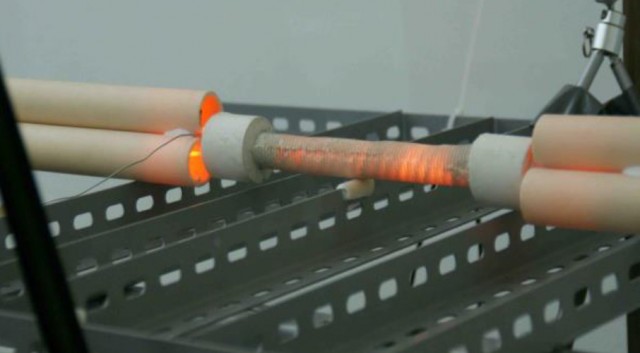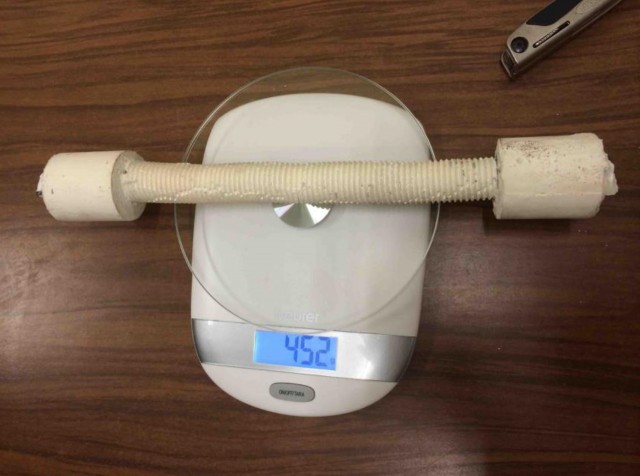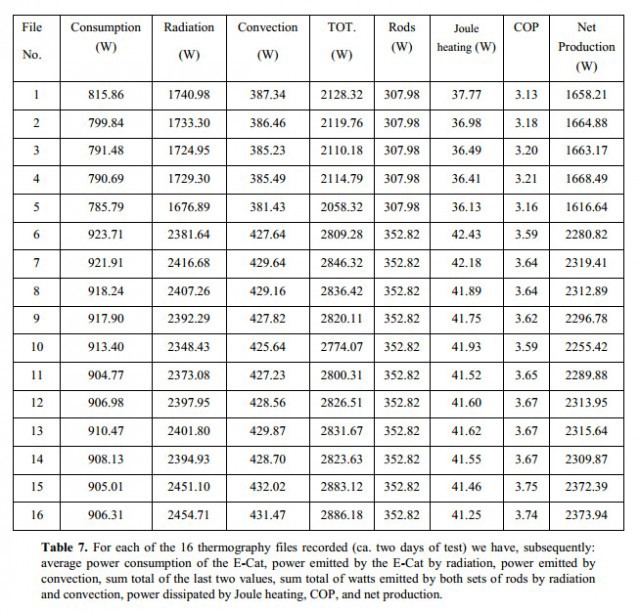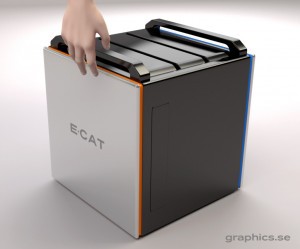The first independent confirmation of LENR (in simple terms - cold fusion)?
- Transfer
LENR - Low-energy nuclear reaction - Low-energy nuclear reaction.
I must say right away that this is only the first step and further more serious tests and one more confirmation from another independent team are needed.

The inventor E-Cat, Andrea Rossi , a device that uses cold fusion to generate large amounts of low-cost green energy, was tested in March 2014 by an independent team of scientists who have now submitted a 54-page report.
They explored the small E-Cat for 32 days, during which the reactor produced 1.5 megawatt hours of energy. This is "much more than can be obtained from any known chemical source for a reactor of this size."
It is interesting that in the report itself it is written that 32 days is a predefined period of the experiment. That is, the reactor was turned off artificially, and by that time, it still did not show any signs of a decrease in the power output.
A study of the fuel before and after the tests showed that the isotopes in the used fuel could only be obtained through nuclear reactions. This conclusion struck the researchers: "... of course, it is very difficult to understand exactly how these synthesis processes can take place at such low energies."
This E-Cat Report (pdf)was prepared by six reputable scientists from Italy and Sweden. Despite the fact that this version of E-Cat is very different from the previous ones , the researchers say that it also uses “hydrogen rich nickel” with some additives (mainly lithium) as fuel. The inventor of the reactor Andrea Rossi claims that E-Cat uses cold fusion - a low-energy nuclear reaction, LENR - for the synthesis of copper by combining atoms of nickel and hydrogen, with the release of a large amount of energy.
In analyzing the fuel before and after the 32-day experiment, the researchers found that the isotopes almost completely transformed from the “natural” mixture of Nickel-58/60 to Nickel-62. And this reaction, according to scientists, is impossible without nuclear fusion reactions. Researchers say that only 1 gram of fuel was used. For more information on the scientific / chemical processes behind LENR, read our previous article on the Rossi device.

Weighing the New E-Cat Reactor
Researchers are very cautious in their conclusions, they do not directly state that it is LENR / cold fusion that is the source of energy in E-Cat. Instead, it refers to an “unknown reaction.”
In the serious scientific community, LENR is still not perceived as a joke (or even a taboo topic). The situation turns out to be funny: the researchers really try to understand exactly how the E-Cat generates so much energy and still come to the conclusion that the only option is synthesis, but then cool the ardor, adding that this is just a discussion, not a serious assumption.

Test stand
In any case, let's now drop the necessary skepticism and look at what is really interesting: the completely insane amount of energy generated by the E-Cat. The plate below shows some numbers from this 32-day trial. The most important numbers on the right are: COP (productivity ratio) reaches 3.74, and net energy production - up to 2373 watts. For a minute, this is a small device that shows similar data for 32 consecutive days. The total amount of energy generated in 32 days was 1.5 MW * h.

It turns out that the E-Cat, studied by scientists, has an energy capacity of 1.6 × 10 9 W * h / kg and a power of 2.1 × 10 6 W / kg.
The orders of magnitude of these values are higher than anything tested so far: the reactor turns out to be about 100 times more powerful than the best supercapacitors and possibly a million times more energy-intensive than gasoline. According to the researchers, "such values put the E-Cat above any known traditional energy sources."
Obviously, if you believe this independent research, and if the E-Cat really uses cold fusion, this is very impressive news. After all, we are talking about an extremely cheap, environmentally friendly, energy-intensive source that can literally change the world.

Estimated type of commercial product
However, before changing the world, one must go through a period of very close attention of a large scientific community. The previous independent E-Cat review of March 2013 was quickly discredited by critics. Now it seems that the new report has been executed more efficiently, with fewer holes and inconsistencies. The test report was sent to Arxiv, a prepress article server, with the hope of future publication in the Journal of Nuclear Physics.
The next few weeks can be extremely interesting. According to Sifferkoll , a large bank downloaded the new E-Cat report just a few minutes after it was posted online - and oil futures are still volatile. And this morning, the University of Glasgow announced that it was going to sell its investments in fossil fuels. Hmm ...
Upd.
An important detail: the report says that to evaluate the emitted energy, heat and other radiation emitted by the reactor were measured, and not electricity directly. That is, we are laying more losses on the conversion.
Upd.2
In the report, the researchers claim that the input power (900W) was artificially limited due to fears that something could melt and leak, or something else would happen. They write that when the input power increased by about 100W (from 790 to 900), the output power jumped by 700W, and the temperature rose from 1260 ° C to 1400 ° C in a couple of minutes. And that to study the limits of the capabilities of this reactor, other experiments are needed.
I must say right away that this is only the first step and further more serious tests and one more confirmation from another independent team are needed.

The inventor E-Cat, Andrea Rossi , a device that uses cold fusion to generate large amounts of low-cost green energy, was tested in March 2014 by an independent team of scientists who have now submitted a 54-page report.
Testers
Giuseppe Levy - University of Bologna, Italy
Evelyn Fosci - Bologna, Italy
Bo Hoysted, Roland Petterson and Lars Tegner - Uppsala University, Sweden
Hanno Essen - Royal Institute of Technology, Stockholm, Sweden
Evelyn Fosci - Bologna, Italy
Bo Hoysted, Roland Petterson and Lars Tegner - Uppsala University, Sweden
Hanno Essen - Royal Institute of Technology, Stockholm, Sweden
They explored the small E-Cat for 32 days, during which the reactor produced 1.5 megawatt hours of energy. This is "much more than can be obtained from any known chemical source for a reactor of this size."
It is interesting that in the report itself it is written that 32 days is a predefined period of the experiment. That is, the reactor was turned off artificially, and by that time, it still did not show any signs of a decrease in the power output.
A study of the fuel before and after the tests showed that the isotopes in the used fuel could only be obtained through nuclear reactions. This conclusion struck the researchers: "... of course, it is very difficult to understand exactly how these synthesis processes can take place at such low energies."
This E-Cat Report (pdf)was prepared by six reputable scientists from Italy and Sweden. Despite the fact that this version of E-Cat is very different from the previous ones , the researchers say that it also uses “hydrogen rich nickel” with some additives (mainly lithium) as fuel. The inventor of the reactor Andrea Rossi claims that E-Cat uses cold fusion - a low-energy nuclear reaction, LENR - for the synthesis of copper by combining atoms of nickel and hydrogen, with the release of a large amount of energy.
In analyzing the fuel before and after the 32-day experiment, the researchers found that the isotopes almost completely transformed from the “natural” mixture of Nickel-58/60 to Nickel-62. And this reaction, according to scientists, is impossible without nuclear fusion reactions. Researchers say that only 1 gram of fuel was used. For more information on the scientific / chemical processes behind LENR, read our previous article on the Rossi device.

Weighing the New E-Cat Reactor
Researchers are very cautious in their conclusions, they do not directly state that it is LENR / cold fusion that is the source of energy in E-Cat. Instead, it refers to an “unknown reaction.”
In the serious scientific community, LENR is still not perceived as a joke (or even a taboo topic). The situation turns out to be funny: the researchers really try to understand exactly how the E-Cat generates so much energy and still come to the conclusion that the only option is synthesis, but then cool the ardor, adding that this is just a discussion, not a serious assumption.

Test stand
In any case, let's now drop the necessary skepticism and look at what is really interesting: the completely insane amount of energy generated by the E-Cat. The plate below shows some numbers from this 32-day trial. The most important numbers on the right are: COP (productivity ratio) reaches 3.74, and net energy production - up to 2373 watts. For a minute, this is a small device that shows similar data for 32 consecutive days. The total amount of energy generated in 32 days was 1.5 MW * h.

It turns out that the E-Cat, studied by scientists, has an energy capacity of 1.6 × 10 9 W * h / kg and a power of 2.1 × 10 6 W / kg.
The orders of magnitude of these values are higher than anything tested so far: the reactor turns out to be about 100 times more powerful than the best supercapacitors and possibly a million times more energy-intensive than gasoline. According to the researchers, "such values put the E-Cat above any known traditional energy sources."
Obviously, if you believe this independent research, and if the E-Cat really uses cold fusion, this is very impressive news. After all, we are talking about an extremely cheap, environmentally friendly, energy-intensive source that can literally change the world.

Estimated type of commercial product
However, before changing the world, one must go through a period of very close attention of a large scientific community. The previous independent E-Cat review of March 2013 was quickly discredited by critics. Now it seems that the new report has been executed more efficiently, with fewer holes and inconsistencies. The test report was sent to Arxiv, a prepress article server, with the hope of future publication in the Journal of Nuclear Physics.
The next few weeks can be extremely interesting. According to Sifferkoll , a large bank downloaded the new E-Cat report just a few minutes after it was posted online - and oil futures are still volatile. And this morning, the University of Glasgow announced that it was going to sell its investments in fossil fuels. Hmm ...
Upd.
An important detail: the report says that to evaluate the emitted energy, heat and other radiation emitted by the reactor were measured, and not electricity directly. That is, we are laying more losses on the conversion.
Upd.2
In the report, the researchers claim that the input power (900W) was artificially limited due to fears that something could melt and leak, or something else would happen. They write that when the input power increased by about 100W (from 790 to 900), the output power jumped by 700W, and the temperature rose from 1260 ° C to 1400 ° C in a couple of minutes. And that to study the limits of the capabilities of this reactor, other experiments are needed.
